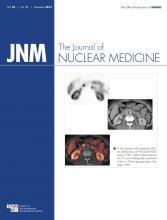TO THE EDITOR: The article by Kurdziel et al. (1) focused mainly on the kinetics of 18F-NaF and reproducibility of studies using PET scanners. In addition, the authors presented a dosimetric result that should be emphasized, in our opinion.
Based on the measured biodistribution of 18F-NaF, the authors calculated organ doses using OLINDA. With the highest organ dose being found in the urinary bladder wall (0.08 mGy/MBq), the mean effective dose for 8 patients was 0.017 mSv/MBq. The mean administered activity of 141 MBq corresponds to an effective dose of 2.4 mSv per 18F-NaF examination. Hence, the effective dose is 20% lower than the effective dose for skeletal scintigraphy using 99mTc-methylene diphosphonate (MDP), that is, 2.95 mSv with a mean administered activity of 518 MBq (2). In this report, Grant et al. listed an effective dose of 3.99 mSv using 148 MBq of 18F-NaF (2). The difference is related to the biokinetic data. As Kurdziel et al. explained, their measured urinary excretion fraction (15.3%) and biologic half-life (1.37 h) were lower than the data given in ICRP report 53 (50% excretion fraction) (3).
Our own experiences indicate a nearly 50% excretion fraction, too. Nevertheless, the effective dose might be less than the values obtained by Grant et al. based on the simple bladder model that is implemented in OLINDA. A more realistic dynamic urinary bladder model that considers different parameters such as initial bladder volume, initial voiding time, voiding interval, and bladder fill rate is described in MIRD pamphlet 14 (4).
Because of the detailed data on organ doses that Kurdziel et al. provide, we performed dose calculations using OLINDA and the dynamic urinary bladder model. For convenience, a software tool based on the dynamic urinary bladder model was developed (http://nuklearmedizin.uniklinikum-dresden.de/forschung-research/mird-14-dosis-kalkulator/). For 18F-NaF, the bladder dose could be reduced by 25% if the voiding interval was shortened to 2 h with a first voiding at 60 min after injection. Additionally, a dose reduction of 70% can be achieved by increasing the initial bladder volume at the time of administration from 0 to 300 mL. Thus, optimizing the voiding scheme can reduce the effective dose significantly because the urinary bladder wall is the organ with the highest dose.
Assuming a clinical setup (300-mL initial bladder volume, first voiding at 60 min after injection, voiding interval of 2 h), the bladder dose is 30% lower than the dose calculated with OLINDA and results in an effective dose of 2.96 mSv per 18F-NaF examination. The effective dose can be additionally reduced to 2.26 mSv by good hydration of the patients, as can be demonstrated in the model calculations by increasing the urine flow rate from 1 to 5 mL/min. These effects are less pronounced in 99mTc-MDP because of the different physical properties and different local dose depositions of γ-rays and positrons. Applying these considerations to clinical practice, the radiation exposure of the patients can be reduced remarkably when using 18F-NaF as a radiotracer that provides better imaging properties than 99mTc-MDP (5).
The “SNM Practice Guideline for Sodium 18F-Fluoride PET/CT Bone Scans 1.0” (6) points out that conventional bone scans cause lower radiation doses than 18F-NaF bone scans (effective dose of 8.9 mSv compared with 5.3 mSv); however, the above-mentioned details have not been taken into consideration. Additionally, the administered activity may be reduced. As Kurdziel et al. stated, they obtained high-quality images by administering only 111–185 MBq of 18F-NaF (1).
From the view of radiation protection, 18F-NaF ought to replace 99mTc-MDP wherever available, and the imaging should be performed with a prefilled urinary bladder.
Footnotes
Published online Sep. 6, 2012.
- © 2012 by the Society of Nuclear Medicine and Molecular Imaging, Inc.







